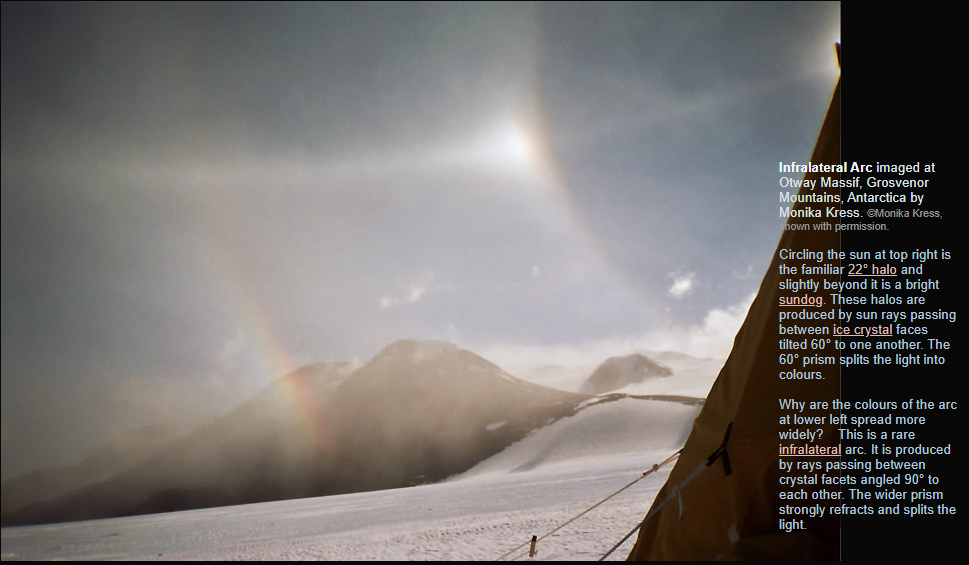60 and 90°
Exploring the Phenomenon of 60 and 90° Atmospheric Optics
Atmospheric optics never ceases to amaze with its stunning displays of light and color. Among these captivating phenomena are the 60 and 90° optical effects, which produce remarkable arcs in the sky. While many of us may be familiar with the 22° halo and sundogs, there is much more to discover when it comes to the spread of colors and the unique characteristics of these arcs.
The 60° prism plays a key role in creating the 22° halo and sundogs. Ice crystals in the atmosphere have faces tilted at an angle of 60° to each other. As sunlight passes through these crystals, it undergoes refraction and splitting, resulting in the beautiful display of colors we observe. The 60° prism acts as a sort of prism, separating the light into its constituent hues.
However, there is another phenomenon that exhibits a wider spread of colors - the rare infralateral arc. Unlike the 60° prism, this arc is produced by rays passing between crystal facets angled at 90° to each other. This larger angle causes a stronger refraction and splitting of light, resulting in a more pronounced dispersion of colors.
The infralateral arc is a captivating sight, but its occurrence is relatively uncommon compared to the more frequently observed 22° halo and sundogs. This rarity adds to its allure and makes it a sought-after sight for skywatchers and photographers alike.
To fully appreciate the intricacies of these atmospheric optics phenomena, it is essential to understand the underlying principles at play. The refraction and splitting of light by ice crystals provide us with an opportunity to witness nature's own prismatic effects. The varying angles between crystal faces determine the degree of dispersion, resulting in different arcs with distinct color spreads.
In addition to their aesthetic appeal, studying these atmospheric optics phenomena can provide valuable insights into the properties of ice crystals in the atmosphere. By analyzing the characteristics of the arcs, scientists can gain a deeper understanding of crystal formation and orientation, which contributes to our knowledge of atmospheric conditions.
It is worth noting that atmospheric optics is a field of study that continues to evolve. Researchers and enthusiasts are constantly exploring new techniques and technologies to capture and analyze these optical phenomena. Advancements in high-resolution imaging, spectroscopy, and modeling allow for more detailed observations and simulations, enabling us to unravel the mysteries of these breathtaking displays.
In conclusion, the 60 and 90° atmospheric optics phenomena offer a fascinating glimpse into the intricate workings of light and ice crystals in the atmosphere. From the familiar 22° halo and sundogs to the rare infralateral arc, each display showcases the beauty and complexity of nature's own prismatic effects. By delving deeper into the study of these phenomena, we can unravel the secrets of ice crystal formation and gain a greater understanding of our ever-changing atmosphere. So next time you find yourself gazing at the sky, take a moment to appreciate the wonders of atmospheric optics unfolding above you.

Infralateral Arc imaged at Otway Massif, Grosvenor Mountains, Antarctica by Monika Kress. ©Monika Kress, shown with permission.
Circling the sun at top right is the familiar 22° halo and slightly beyond it is a bright sundog. These halos are produced by sun rays passing between ice crystal faces tilted 60° to one another. The 60° prism splits the light into colours.
Why are the colours of the arc at lower left spread more widely? This is a rare infralateral arc. It is produced by rays passing between crystal facets angled 90° to each other. The wider prism strongly refracts and splits the light.
Note: this article has been automatically converted from the old site and may not appear as intended. You can find the original article here.
Reference Atmospheric Optics
If you use any of the definitions, information, or data presented on Atmospheric Optics, please copy the link or reference below to properly credit us as the reference source. Thank you!
-
<a href="https://atoptics.co.uk/blog/60-and-90/">60 and 90°</a>
-
"60 and 90°". Atmospheric Optics. Accessed on April 24, 2024. https://atoptics.co.uk/blog/60-and-90/.
-
"60 and 90°". Atmospheric Optics, https://atoptics.co.uk/blog/60-and-90/. Accessed 24 April, 2024
-
60 and 90°. Atmospheric Optics. Retrieved from https://atoptics.co.uk/blog/60-and-90/.